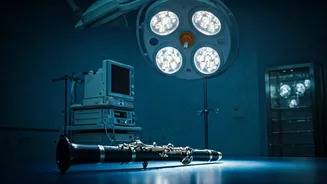Deep Brain Stimulation Explained
Deep brain stimulation (DBS) is a significant surgical intervention primarily aimed at mitigating the symptoms of Parkinson's disease, a progressive neurological
disorder that affects movement. This procedure entails implanting electrodes into specific areas deep within the brain, particularly those regions associated with motor control and the regulation of movement. These electrodes are meticulously placed to target the overactive or malfunctioning circuits that contribute to the hallmark symptoms of Parkinson's, such as tremors, rigidity, and slowed movements. Once in place, these electrodes are connected via wires, running beneath the skin, to a pulse generator (a small battery-powered device) which is typically implanted under the skin in the chest. This generator then delivers electrical impulses to the brain, effectively modulating the problematic neural activity and alleviating symptoms. The entire process requires careful planning and execution by a team of specialized medical professionals. This team typically includes a neurologist specializing in movement disorders, a neurosurgeon, and often, an anesthesiologist. The precision required is paramount to ensure the electrodes are accurately positioned to achieve the best possible therapeutic effects while minimizing potential side effects. The success of DBS relies on accurate targeting and programming of the electrical stimulation to suit each patient's unique needs and symptom profile. Following the surgery, the device is carefully calibrated and adjusted over several follow-up appointments with the neurology team to optimize its effectiveness and ensure the patient's comfort and well-being.
The Surgical Procedure Unveiled
The surgery itself typically involves a series of steps designed to ensure the accurate placement of the DBS electrodes. Initially, the patient undergoes advanced neuroimaging, such as MRI or CT scans, to create a detailed map of the brain. This imaging data is used to pinpoint the exact location for the electrodes. The patient's head is then secured in a stereotactic frame, a rigid device that provides precise measurements and guidance for the surgical tools. This frame ensures that the electrodes are placed with millimeter accuracy, which is critical for maximizing therapeutic effects and minimizing unwanted side effects. The neurosurgeon makes a small incision in the scalp and drills a tiny hole in the skull to access the brain. The electrodes are then carefully inserted through this opening and advanced toward the targeted brain regions. During the insertion process, the patient may be awake and responsive, as it was in the case of the UK woman, so that the surgical team can monitor the effects of the stimulation. This allows the surgeon to assess the immediate impact on the patient's symptoms and make adjustments if necessary. Throughout the procedure, a neurologist or neurophysiologist monitors the patient's brain activity and movement, helping guide the placement of the electrodes. The use of this real-time feedback helps ensure optimal electrode placement and helps to limit the chances of hitting regions of the brain which may affect motor function or cause other difficulties. Once the electrodes are correctly positioned, they are anchored in place. The wires connecting the electrodes to the pulse generator are then tunneled under the skin, usually leading to the chest. Finally, the pulse generator is implanted in the chest and the incisions are closed, completing the surgery. After the surgery, the generator is programmed by a neurologist, and fine-tuning occurs in the following weeks and months, to maximize symptom relief and minimize side effects, creating a tailored treatment plan.
Clarinet During Surgery
In some cases, as observed in the UK woman's experience, patients may be awake during the insertion of the electrodes. The fact that she played her clarinet during the procedure provides valuable feedback to the surgical team. When the patient is conscious, the surgical team can observe and assess the impact of the stimulation on the patient’s symptoms in real-time. This dynamic feedback loop allows the surgeon to adjust the electrode placement precisely to achieve the best therapeutic results. The decision to keep the patient awake during this part of the procedure is not random; it serves a crucial purpose: to minimize the chance of damaging nearby parts of the brain that control movement and other functions. By engaging in activities, like playing an instrument or moving their limbs, the patient can provide feedback to the medical team, ensuring that the electrodes are positioned correctly and not causing any adverse effects. The patient’s ability to actively participate enhances the precision and safety of the surgery. The fact that a patient can perform such a complex task during neurosurgery is a testament to the safety and sophistication of the technique, and the skill of the surgical team. This also emphasizes that the procedure is designed to improve the quality of life for people with Parkinson's and allow them to get back to enjoying activities they love.
Post-Surgery and Recovery
After the DBS surgery is complete, the recovery phase begins, which is a gradual process involving several stages. In the immediate aftermath, patients typically stay in the hospital for a few days to monitor for any complications. The medical team will closely observe the patient for any signs of infection, bleeding, or neurological changes. Pain management will be a priority, with medications administered to keep the patient comfortable. Once the patient is deemed stable, they are typically discharged home, but ongoing follow-up appointments with their neurologist and other healthcare professionals are essential. These appointments are crucial for adjusting the settings on the pulse generator, which controls the electrical impulses delivered to the brain. The neurologist fine-tunes these settings to optimize symptom relief and minimize side effects, a process that can take several weeks or months. During this time, the patient’s symptoms are carefully monitored, and the generator's settings are adjusted to achieve the best possible balance of symptom control and comfort. In addition to medical care, physical, occupational, and speech therapy can play a vital role in recovery. These therapies can help patients regain strength, improve their motor skills, and address any speech or swallowing difficulties. The patient will gradually return to their normal daily activities, with the goal of achieving the highest possible quality of life. The effectiveness of DBS in managing Parkinson's symptoms can vary from person to person. However, many patients experience significant improvements, leading to reduced tremors, rigidity, and other debilitating effects of the disease. This can mean greater freedom of movement, a decrease in medication usage, and an overall improvement in their daily life.














